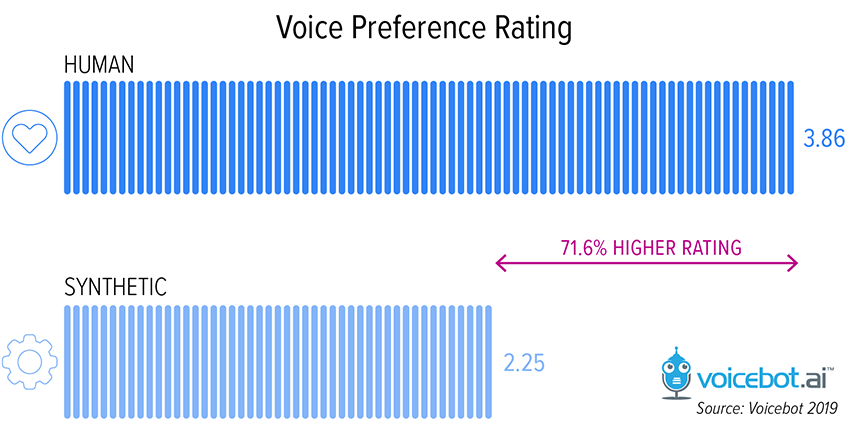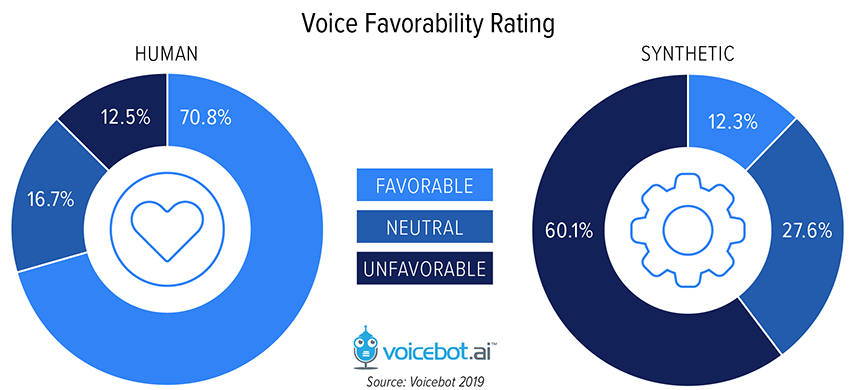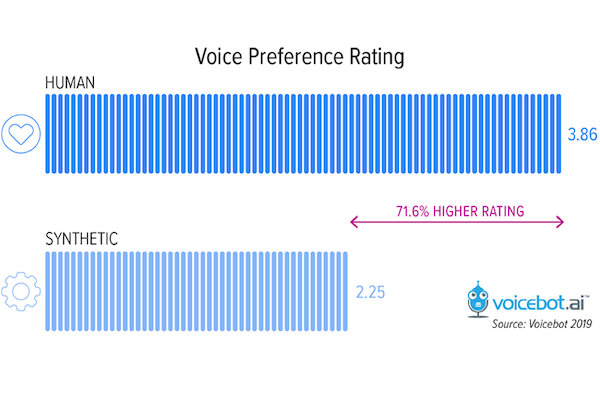New Report Says Consumers Have 71% Preference for Human Over Robot Voices for Voice Assistant User Experience
Voicebot Research has found that not only do consumers prefer human voices over synthetic in their voice experiences, but the difference is 71.6% more. That is one of the findings in the newly published report What Consumers Want in Voice App Design. From what we can tell, no one has published results from a study looking to measure the preference between the two approaches. And, this was just one of the many questions that have remained unexplored in voice user experience.

However, the existence of actual data measuring preferences enables discussions about voice app design to suddenly become informed by more than mere opinion. “Smart marketers know that people prefer listening to people that sound like them. With this new research, it’s further evidence that the voice—a human quality full of emotion—is not easily replicated,” says David Ciccarelli, co-founder and CEO of Voices.
Adding Data to the Voice UX Conversation
The rapid proliferation of voice assistants and voice user interfaces has led to debates about how to define a good voice user experience. Until today, those debates have been devoid of data and founded solely on individual opinions.
Voicebot would frequently receive questions such as “how long is optimal for a voice assistant response?” and “will using voice actors increase the user ratings for my Alexa skill?” Again, there were plenty of opinions such as “keep it short except when your experience needs a longer response” and “use a voice actor if you have time and budget.” Most voice app developers didn’t find these answers very helpful. We wondered why there was no research attempting to answer these basic questions, but could not locate any.
So, Voicebot collaborated with Voices.com and Pulse Labs to see if we could design an empirical study that would put some data behind answering a series of questions. Along the way, we were also supported by Meredith Corporation and Skilled Creative that also expressed interest in whether there was some empirical guidance for voice experience optimization. The full report includes 17 charts in 19 pages of analysis and addresses questions such as:
- Do voice assistant users prefer human voices over synthetic voices and if so, by how much?
- Do users prefer male or female voices? Is that preference the same when considering human or synthetic voices?
- How does the age of the user impact these preferences?
- How long is too long when delivering content through a voice assistant?
- Is there a difference in tolerance for the length of voice assistant content delivered by a human compared to a synthetic voice?
Applying the Results
Consumer preference for human voices also showed up clearly in voice favorability ratings by our panel of 249 testers. While 70.8% had a favorable view of human voices and only 12.5% unfavorable, ratings for synthetic voices were reversed with 12.3% favorable and 60.1% unfavorable.
“When designing for voice, there’s a great opportunity for brands and serious developers to determine and guide what their voice will be. What this work exemplifies is how important it is to take that voice seriously and to get it right, as it can make the difference between whether a consumer remembers what you’ve built or not,” said Dylan Zwick, Pulse Labs, co-founder and chief product officer.

Brandon Kaplan, CEO of Skilled Creative added, “While we weren’t surprised by the overall result, we were a bit surprised at the size of the discrepancy. It’s clear that if you’re building an application that speaks for longer than a few words, you should really look into using recorded voices. We would, however, recommend using synthetic voices during development and testing, and only adding recorded voices when you know you’ve got the interaction right, because once recordings are made it’s hard to make modifications.”
To learn more about consumer preferences by age and gender as well as their recall based on content length, and provenance and more, download the full report below. Also, let us know what you think on Twitter.
Download
Follow @bretkinsella Follow @voicebotai









